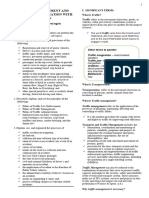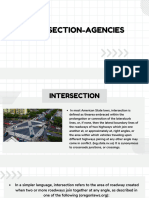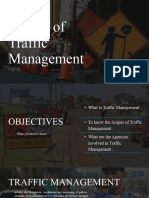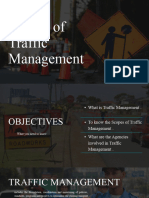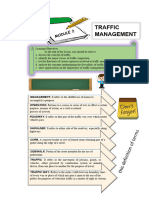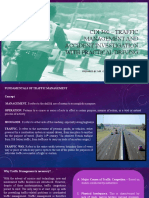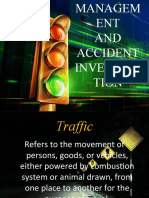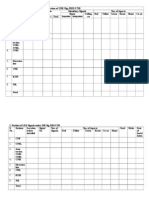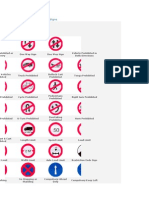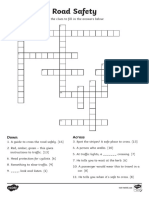1
2
�3
�4
�5
� Define traffic Management;and
Differentiate the types of traffic management and its importance.
MAINLESSON
What is TRAFFIC MANAGEMENT?
● Is the application of the processes and skills in planning, organizing, staffing, directing,
coordinating and budgeting to trafficaffairs.
● Also refers to activities undertaken by a highway transportation agency to improve roadway
system safety, efficiency, and effectiveness of both providers and consumers of transportation
services.
Types of Traffic Management
1. Traditional traffic engineering tools or devices, to regulate or control traffic, such as traffic lights,
traffic signals, or pavement markings, traffic islands and other devices that could control or direct the
flow oftraffic.
2. Advanced technology like the Intelligent Transportation System (ITS). Examples are installation of
road sensors for emergency cars, global positioning devices on motor vehicles, and road sensors
attached to traffic signallights.
Traffic management is designed to make the traff
Why is Traffic Management Necessary?
In every traffic management, three elements are
necessary to be considered.
Road Traffic
system
Road Users
MAJOR CAUSES OF TRAFFIC CONGESTION SPECIFIC TRAFFIC PROBLEMS
PHYSICAL INADEQUACY Traffic build up – gradual increase of traffic
● Lack ofroads users in a given portion of the highway.
6
� ● Narrowbridges Traffic Congestion – slow speeds, longer trip
● Lack of trafficfacilities times, and increased vehicular line up.
POOR CONTROL MEASURES Traffic Jams – movement of traffic users (motor
● Ineffective mechanical controldevices vehicles or pedestrians) is very slow or
stationary.
● Poor implementation of traffic laws, rules andTraffic Jams – movement of traffic users (motor
regulations vehicles or pedestrians) is very slow or
stationary.
HUMAN ERRORS Bottlenecks – narrow points or areas in
● Traffic congestion caused by slow drivers, or highways where traffic jams and congestion
poor driving habits, pedestrian mistakes, usually occurs.
officer’s errors and traffic accidents which Gridlocks – severe road congestion arising
mostly attributed to humanerrors. when continuous line up of vehicles block an
entire network of intersecting streets, bringing
traffic in a direction to a completestandstill.
POOR MAINTENANCE
Collisions – instances of one moving traffic unit
● Unrepaired diggings, cracks on road pavement
or person striking violently against another.
or unfinished road pavementconcreting.
Agencies Involved in traffic Management
1. Department of Transportation(DOTr)
- through the Land Transportation Office (LTO) responsible for the implementation of the
Land Transportation Code of the Philippines (RA 4136) particularly the issuance of the driver’s
licenses and registration of motor vehicle and through the Land Transportation Franchising and
Regulatory Board (LTFRB) approving franchise for conveyances and conducting traffic safety
seminars.
2. City or Municipal Engineer’sOffice
– responsible for planning, construction and maintenance of traffic facilities within their
respective locality.
3. Department of Public Works and Highways(DPWH)
- responsible for the planning, construction, maintenance of traffic facilities particularly those
categorized as national highways and other major roadarteries.
4. Legislative (Congress/City or MunicipalBoards)
- passing and amending laws concerning traffic and also involved in planning and approval
of governmentprojects.
5. PNP - HPG (Highway Patrol Group – is responsible for direct enforcement of traffic laws,
rules andregulations.
6. Traffic Management Bureaus(TMBs)
- These are offices created mostly under the office of city/municipal mayors with the primary
task of assisting the local PNP traffic units in the enforcement of trafficlaws/ordinances.
7. AcademicInstitution
- Schools both public and private are responsible for traffic education by integrating respective
programs and curriculum subjects or topics on trafficsafety.
8. Court is responsible for adjudication of traffic-related cases filed beforethem.
9. Public InformationOffice
7
� Provide s the necessary updated information to the public by creating traffic safety campaigns and
other activities relating to traffic.
10. Citizens SupportGroup
Private institutions or organizations also help in the prevention of traffic congestion by assisting
government offices in various activities or during special occasions and holidays where traffic
problem is likely tohappen
11. Barangay Peacekeeping Action Team (BPAT)Members
The Barangay Tanod of barangay security forces are the usual traffic control officers in their
respective localities during times of emergencies.
12. Tri-Media (Including theinternet)
Government and privately-owned publications and radio and television broadcasting companies
provide necessary and updated traffic-related information to the public through their respective
programs.
Skill-buildingActivities
THINK LIKE A TRAFFIC ENFORCER. In this activity, I want you to state in one sentence why you think
traffic management is necessary in these three elements. (15 points)
ROAD TRAFFIC SYSTEM ROAD USERS
ROAD ENFORCEMENT
8
�FAQs
Terms to remember to better understand traffic management are the following:
1. ARTERIAL HIGHWAYS/ROADS – these are high capacity urban roads that direct traffic from
collector roads to expressway or freeways. It also refers to a highway that is used primarily through
traffic.
2. COLLECTOR HIGHWAY – also known as collector road or distributor road which connects low to
moderate highways or roads to arterial highways such as those entering residentialproperties.
3. HIGHWAY – means the entire width between the boundary lines of every way dedicated to a public
authority when any part of the way is open to the use of the public for purposes of vehicular traffic. It
refers also to any roads, streets, or avenues used as publicthoroughfare.
4. ROADWAY – refers to the part of the traffic way over which motor vehicles pass. Roads can be
classifiedas:
a. National Roads – roads or streets interconnecting provinces and/orcities.
b. Provincial Roads – road/streets interconnecting municipalities and/or cities within aprovince.
c. City Roads – roads/streets interconnecting barangays within acity.
d. Municipal Roads – roads/streets interconnecting barangays within amunicipality.
e. Barangay Roads – roads/streets located within a barangay which connect sitios or places
within abarangay.
5. SHOULDER – it refers to either side of the roadway especially alonghighways.
6. SIDEWALK – refers to paved walkway along thestreets
7. THROUGH HIGHWAY – means every highway or portion thereof on which vehicular traffic is given
the right of way, and at the entrances to which vehicular traffic from intersecting highways is required
by law to yieldright-of-way.
8. THRUWAY OR THROUGH WAY – a highway that has limited entrances and exits such as the
expressways, freeways, ormotorways.
9. TRAFFIC – refers to the movement of persons, goods, or vehicles, either powered by a combustion
system or animal drawn from one place to another for the purpose oftravel.
10. TRAFFIC WAY – refers to the entire width between boundary lines of every way or place of which
any part is open to the use of the public for purposes of vehicular traffic as a matter of right or
custom.
11. INTERSECTION – refers to the area of the roadway created when two or more roadways join
together at any angle, as described in one of thefollowing:
a. If the roads have curbs, the intersection is the area embraced within the prolongation or
connection of the lateral curblines.
b. If the roadway does not have curbs, the intersection is the area embraced within the
prolongation or connection of the lateral boundary lines of theroadways.
i. Classification of intersection according to number of intersectingroads:
1. 3-way Intersection - commonly known as T or Y crossroad which links three
roads.
2. 4-way Intersection – most common type which involved the crossing of two
roadways. Regular intersection (when the two roads cross perpendicularly)
and Skewed Intersection (two roads cross at differentangles)
3. 5-way Intersection – involves the crossing of fiveroads.
4. 6-way Intersection – involves the crossing of three streets most often two
perpendicular roads and one diagonalroad.
5. Staggered Intersection – it involves two successive Tcrossroads.
Classification of INTERSECTION ACCORDING TO TRAFFIC CONTROL
6. Controlled intersection – is controlled by traffic controldevices
10
� a. Yield-controlled Intersection – usually controlled by a Yield sign or Give
Waysign.
b. Stop-controlled Intersection – a stop is usually installed. Most common
are the two-waystops.
c. Traffic Circle – flow is directed by a circle, Rotary Island, or a runabout
sign.
7. Uncontrolled intersection – this intersection has no traffic signals, or traffic
signs.
8. Box Junction – this type generally prohibits entry unless the exit isclear.
9. Cloverleaf – a highway interchange at which two highways, one crossing over
the other, have a series of entrance and exit ramps resembling the outline of
the four-leaf clover and enabling vehicles to proceed in either direction on
eitherhighway.
11
�For your assignment to be listed here:
Enumerate and give the function of the AGENCIES INVOLVED IN TRAFFIC MANAGEMENT. Just list at
least five agencies.
12







